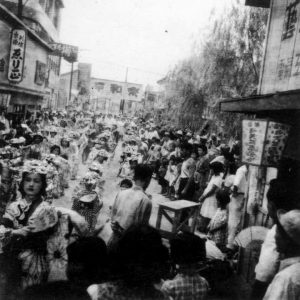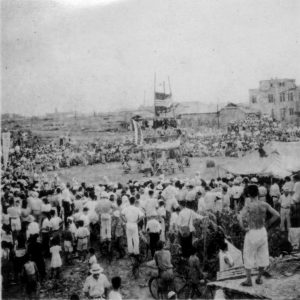Public’s zest for life amid ruined city captured in photos of Hiroshima Prefectural Bon Dance Festival, August 6, 1947, with crowds encircling wooden tower
Aug. 9, 2022
by Michiko Tanaka, Staff Writer
On August 6, 1947, the Hiroshima Prefectural Bon Dance Festival was held in the present-day district of Shintenchi, located in Hiroshima’s Naka Ward. Hiroyuki Mineno, 75, the current owner of an electrical appliance shop in the area of Nagarekawa-cho, also in Naka Ward, has kept on hand photographs from the time of the festival. The photos capture rows of spectators surrounding a yagura makeshift wooden tower in the downtown area of Hiroshima, with damage from the atomic bombing still obvious even two years later. Staff at the Hiroshima Peace Memorial Museum, also in Naka Ward, called the materials “valuable photos that reveal the passion of the public in those days as the city was starting to take the first steps toward recovery.”
The festival was organized by the Chugoku Shimbun as an event linked with the city’s first Peace Festival, the forerunner of today’s Hiroshima Peace Memorial Ceremony. One of Mr. Mineno’s photos shows the newspaper company’s flag hanging from the wooden tower. Four of the photos appear to have been taken at the same venue. Besides those photos, there are also several depicting dancers, donning flower hats, marching on a nearby street.
The prefectural bon dance festival was originally known as the War Victims Memorial Bon Dance Festival, held at the former site of Gokoku Shrine in the area of Motomachi (present-day Naka Ward), on August 7, 1946. According to a newspaper dated to that time, the 1947 festival, with its newly acquired name, had 12 groups performing dances to such songs such as “Heiwa-Odori” (in English, ‘Peace dance’) and “Hiroshima Heiwa Ondo” (‘Hiroshima peace song’). The Peace Festival on that day began with the city mayor’s peace declaration, and then related events such as traditional entertainment performances and a costume parade took place at different venues.
The photos are considered to have been taken by Takayoshi Mineno, Hiroyuki’s uncle and previous president of the electrical appliance shop Mineno Electronics, Co. who died in 1995 at the age of 82. Takayoshi’s hobby was photography. As such, he left behind many photos depicting the Shintenchi vicinity after the war.
Takayoshi was employed as a civilian in the military. The war ended while he was being held in a prisoner-of-war camp in the Philippines. In his hometown of Hiroshima, he had 10 brothers and sisters, but his 13-year-old younger sister was killed in the atomic bombing. Takayoshi began to work with electrical appliances in the Nagarekawa area after returning to Hiroshima, and in that way as the oldest son, supported the family.
Imagining the thoughts of the people captured in Takayoshi’s photos, Hiroyuki said, “I believe they must have worked diligently in Hiroshima, like my uncle, after everything had been lost in the city. Forced to give up so many things starting in the post-war period, they must have been excited to finally have the chance to participate in a festival.”
***
On August 13 and 14th this year, the Chugoku Shimbun is scheduled to hold the Hiroshima Bon Dance, which carries on the original idea of the War Victims Memorial Bon Dance Festival, at Hiroshima Minato Park, located in the neighborhood of Ujinakaigan in the city’s Minami Ward. The event is being held for the first time in three years, after it was suspended due to the coronavirus pandemic. Through a dance known as a “so-odori,” in which anyone can participate, among other performances, the festival is designed to console the souls of A-bomb victims and remember people who worked so diligently in those days to help restore the city.
(Originally published on August 9, 2022)
On August 6, 1947, the Hiroshima Prefectural Bon Dance Festival was held in the present-day district of Shintenchi, located in Hiroshima’s Naka Ward. Hiroyuki Mineno, 75, the current owner of an electrical appliance shop in the area of Nagarekawa-cho, also in Naka Ward, has kept on hand photographs from the time of the festival. The photos capture rows of spectators surrounding a yagura makeshift wooden tower in the downtown area of Hiroshima, with damage from the atomic bombing still obvious even two years later. Staff at the Hiroshima Peace Memorial Museum, also in Naka Ward, called the materials “valuable photos that reveal the passion of the public in those days as the city was starting to take the first steps toward recovery.”
The festival was organized by the Chugoku Shimbun as an event linked with the city’s first Peace Festival, the forerunner of today’s Hiroshima Peace Memorial Ceremony. One of Mr. Mineno’s photos shows the newspaper company’s flag hanging from the wooden tower. Four of the photos appear to have been taken at the same venue. Besides those photos, there are also several depicting dancers, donning flower hats, marching on a nearby street.
The prefectural bon dance festival was originally known as the War Victims Memorial Bon Dance Festival, held at the former site of Gokoku Shrine in the area of Motomachi (present-day Naka Ward), on August 7, 1946. According to a newspaper dated to that time, the 1947 festival, with its newly acquired name, had 12 groups performing dances to such songs such as “Heiwa-Odori” (in English, ‘Peace dance’) and “Hiroshima Heiwa Ondo” (‘Hiroshima peace song’). The Peace Festival on that day began with the city mayor’s peace declaration, and then related events such as traditional entertainment performances and a costume parade took place at different venues.
The photos are considered to have been taken by Takayoshi Mineno, Hiroyuki’s uncle and previous president of the electrical appliance shop Mineno Electronics, Co. who died in 1995 at the age of 82. Takayoshi’s hobby was photography. As such, he left behind many photos depicting the Shintenchi vicinity after the war.
Takayoshi was employed as a civilian in the military. The war ended while he was being held in a prisoner-of-war camp in the Philippines. In his hometown of Hiroshima, he had 10 brothers and sisters, but his 13-year-old younger sister was killed in the atomic bombing. Takayoshi began to work with electrical appliances in the Nagarekawa area after returning to Hiroshima, and in that way as the oldest son, supported the family.
Imagining the thoughts of the people captured in Takayoshi’s photos, Hiroyuki said, “I believe they must have worked diligently in Hiroshima, like my uncle, after everything had been lost in the city. Forced to give up so many things starting in the post-war period, they must have been excited to finally have the chance to participate in a festival.”
***
On August 13 and 14th this year, the Chugoku Shimbun is scheduled to hold the Hiroshima Bon Dance, which carries on the original idea of the War Victims Memorial Bon Dance Festival, at Hiroshima Minato Park, located in the neighborhood of Ujinakaigan in the city’s Minami Ward. The event is being held for the first time in three years, after it was suspended due to the coronavirus pandemic. Through a dance known as a “so-odori,” in which anyone can participate, among other performances, the festival is designed to console the souls of A-bomb victims and remember people who worked so diligently in those days to help restore the city.
(Originally published on August 9, 2022)









